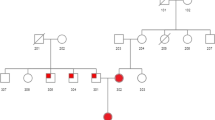Summary
Familial defective apolipoprotein B-100 (FDB) is a recently identified dominantly inherited genetic disorder, which leads to increased serum levels of low density lipoprotein (LDL) cholesterol with reduced affinity for the LDL receptor. This genetic disorder is characterized by defective binding of the apolipoprotein B-100 (apo B-100), which is virtually the sole protein constituent of LDL, to the LDL receptor. The defective binding results from a G to A mutation at amino acid 10708 in exon 26 of the apolipoprotein B (apo B) gene creating a substitution of glutamine for arginine in the codon for amino acid 3500. It is postulated that FDB can exhibit the same clinical features as familial hypercholesterolemia (FH) caused by a defective LDL receptor. The purpose of this paper is to report on an individual with a defective LDL and a defective LDL receptor. The clinical features of this individual were the same as in the family members with either defective LDL or a defective LDL receptor: premature arcus lipoides, tendon xanthomata, and premature atherosclerosis. Although the clinical features were present to the same degree as in individuals with either defect the prognosis and treatment of such an individual could be different.
Similar content being viewed by others
Abbreviations
- FDB:
-
familial defective apolipoprotein B-100
- FH:
-
familial hypercholesterolemia
- LDL:
-
low density lipoprotein
- PCR:
-
polymerase chain reaction
References
Bilheimer DW, Stone NJ, Grundy SM (1979) Metabolic studies in familial hypercholesterolemia: evidence for a gene-dosage effect in vivo. J Clin Invest 64:524–533
Brown SM, Goldstein JL (1974) Familial hypercholesterolemia: defective binding of lipoproteins to cultured human fibroblasts associated with impaired regulation of 3-hydroxy-3-methylglutaryl coenzyme A reductase activity. Proc Natl Acad Sci USA 71:788–792
Brown SM, Goldstein JL (1986) A receptor mediated pathway for cholesterol homeostasis. Science 232:34–47
Goldstein JL, Brown MS (1974) Binding and degradation of low density lipoproteins by cultured human fibroblastscomparison of cells from a normal subject and a subject with homozygous familial hypercholesterolemia. J Biol Chem 249:5153–5162
Havel R, Eder H, Bragdon J (1955) The distribution and chemical composition of ultracentrifugally separated lipoproteins in human serum. J Clin Invest 34:1345–1353
Hobbs HH, Leitersdorf E, Goldstein JL, Brown MS, Russel DW (1989) Multiple crm-mutations in familial hypercholes-terolemia: evidence for 13 alleles, including four deletions. J Clin Invest 81:909–917
Innerarity TL, Weisgraber KH, Arnold KS, Mahley RW, Krauss RM, Vega GL, Grundy SM (1987) Familial defective apolipoprotein B-100: low density lipoproteins with abnormal receptor binding. Proc Natl Acad Sci USA 84:6919–6923
Innerarity TL, Balestra ME, Arnold KS, Mahley RW, Vega GL, Grundy SM, Young SG (1988) Isolation of defective receptor-binding low density lipoproteins from subjects with familial defective apolipoprotein B-100. Arteriosclerosis 8:551a
Innerarity TL, Mahley RW, Weisgraber KH, Bersot TP, Krauss RM, Vega GL, Grundy SM, Friedl W, Davignon J, McCarthy BJ (1990) Familial defective apolipoprotein B-100: a mutation of apolipoprotein B that causes hypercho-lesterolemia. J Lipid Res 31:1337–1349
Keller C, Spengel F, Wieczorek A, Wolfram G, Zöllner N (1981) Familial hypercholesterolemia: a family with divergence of clinical phenotype and biochemical genotype based on fibroblast studies. Ann Nutr Meta 25:79–84
Keller C, Harders-Spengel K, Spengel F, Wieczorek A, Wolfram G, Zöllner N (1981) Serum cholesterol levels in patients with familial hypercholesterolemia confirmed by tissue culture. Atherosclerosis 39:51–59
Knott TJ, Pease RJ, Powell LM, Wallis SC, Rall SC, Innerarity TL, Blackhart B, Taylor WH, Marcel Y, Milne R, Johnson D, Fuller M, Lusis AJ, McCarthy BJ, Mahley RW, Levy-Wilson B, Scott J (1986) Complete protein sequence and identification of structural domains of human apolipoprotein B. Nature 323:734–738
Kunkel LM, Smith KD, Boyer SH, Borgaonkar DS, Wachtel SS, Miller OJ, Breg WR, Jones HW, Rary JM (1977) Analysis of human Y-chromosome-specific reiterated DNA in chromosome variants. Proc Natl Acad Sci USA 74:1245–1249
Lowry OH, Rosebrough NL, Farr AL, Randall RJ (1951) Protein measurement with Folin phenol reagent. J Biol Chem 193:265–275
Ludwig EH, McCarthy BJ (1990) Haplotype analysis of the human apolipoprotein B mutation associated with familial defective apolipoprotein B-100. Am J Hum Genet 47:712–720
Rauh G, Schuster H, Fischer J, Keller C, Wolfram G, Zöllner N (1991) Familial Defective Apolipoprotein B-100: Haplotype analysis of the arginine(3500)→ glutamine mutation. Atherosclerosis 88: (in press)
Saiki RK, Gelfand DH, Stoffel S, Scharf SJ, Higuchi RG, Horn TT, Mullis KB, Erlich HA (1988) Primer-directed enzymatic amplification of DNA with thermostable DNA polymerase. Science 239:487–591
Schuster H, Rauh G, Kormann B, Hepp T, Humphries S, Keller C, Wolfram G, Zöllner N (1990) Familial defective apolipoprotein B-100: comparison with familial hypercholesterolemia in 18 cases detected in Munich. Arteriosclerosis 9:577–581
Soria LF, Ludwig EH, Clarke HRG, Vega GL, Grundy SM, McCarthy BJ (1989) Association between a specific apolipoprotein B mutation and familial defective apolipoprotein B-100. Proc Natl Acad Sci USA 86:587–591
Spengel F, Harders-Spengel K, Keller C, Wieczorek A, Wolfram G, Zöllner N (1982) Use of fibroblast culture to diagnose and genotype familial hypercholesterolemia. Ann Nutr Metab 26:240–247
Tybjærg-Hansen A, Gallagher J, Vincent J, Houlston R, Talmud PJ, Dunning AM, Seed M, Hamsten A, Humphries S, Myant NB (1990) Familial defective apolipoprotein B-100: detection in the United Kingdom and Scandinavia, and clinical characteristics of ten cases. Atherosclerosis 80:235–242
Vega GL, Grundy SM (1986) In vivo evidence for reduced binding of low density lipoproteins to receptors as a cause of primary moderate hypercholesterolemia. J Clin Invest 78:1410–1414
Zöllner N (1958) Arteriosklerose, Stoffwechsel und Ernährung. Münch Med Wochenschr 100:365–367
Author information
Authors and Affiliations
Rights and permissions
About this article
Cite this article
Rauh, G., Schuster, H., Fischer, J. et al. Identification of a heterozygous compound individual with familial hypercholesterolemia and familial defective apolipoprotein B-100. Klin Wochenschr 69, 320–324 (1991). https://doi.org/10.1007/BF01644767
Received:
Accepted:
Issue Date:
DOI: https://doi.org/10.1007/BF01644767




